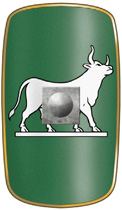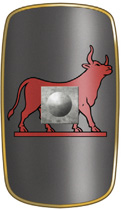Legions of Rome (23 page)
Authors: Stephen Dando-Collins

BATTLE HONORS:
Corbulo’s First Armenian campaign, AD 54–58.
Corbulo’s Second Armenian campaign, AD 62.
The March on Rome, AD 69.
Defeat of the Sarmatians, Moesia, AD 69.
Conquest of Commagene, AD 73.
Trajan’s Eastern campaign, AD 114–116.
Second Jewish Revolt, AD 132–135.
CAESAR’S IRONCLADS
Famous as Caesar’s “Ironclads,” a legion that spent most of its career in Syria, it marched to Rome to make Vespasian emperor, fought in the last battles of the Civilis Revolt, then, based in Galilee, took the brunt of the Second Jewish Revolt
.
The 6th Legion was one of six legions stationed in Spain under the control of Pompey the Great while Caesar was conquering Gaul. During the Gallic War, Pompey loaned the 6th to Caesar for service in Gaul; Cato the Younger protested: “He sent Caesar a force of 6,000 men into Gaul, which Caesar never asked the [Senate] for, nor had Pompey obtained their consent to give.” [Plut.,
Cato
] This was several years before the incident when Caesar and Pompey each contributed a legion to a later aborted mission to the East, after which Caesar’s legion, the 15th, was handed over to Pompey, along with Pompey’s unit, which in that instance was the 1st Legion.
Because the 6th Legion was Pompey’s, Caesar relegated it to mostly rear echelon duties. Pompey took it back by 50
BC
as tensions rose between Caesar and the Senate,
finally erupting into the civil war initiated by Caesar in 49
BC
. The 6th was one of the republican legions that surrendered to Caesar in Spain in 49
BC
, but apparently, along with cohorts of the surrendered 4th Legion, escaped from Spain with Pompey’s generals Afranius and Petreius and joined Pompey in Greece. Seven combined cohorts from these two legions, “the Spanish cohorts, which, as we have said, were brought over by Afranius,” in Caesar’s own words, fought for Pompey in the 48
BC
Battle of Pharsalus. [Caes.,
CW
,
III
, 88]
Following the republican army’s defeat at Pharsalus, cohorts of both the 4th and 6th were among 18,000 Pompeian troops who escaped to North Africa to fight on, leaving just under 1,000 men of the 6th Legion among the troops who surrendered to Caesar. When Caesar’s own men at Pharsalus refused to fight on, he sent them back to Italy with Mark Antony, and negotiated a deal with the men of the 6th. They signed up to march for Caesar, becoming the core of the Caesarian army which conquered the Egyptians then overcame Pharnaces’ chariots at the Battle of Zela in Pontus. Finally, the 6th took part in Caesar’s defeat of Pompey’s sons in Spain. No wonder they called themselves the “ironclads”; in surviving, and winning, against enormous odds, they would have thought themselves impregnable.
Meanwhile, the remaining men of Pompey’s 6th Legion fought on the losing side at Thapsus in North Africa. This second 6th Legion would be fighting for Octavian by 31
BC
and eventually became the 6th Victrix.
Following Caesar’s assassination, the 6th Ferrata Legion marched for Antony until the Actium defeat, then became part of Octavian’s standing army. Octavian sent it to Syria following the death of Antony, and it was based at Raphanaea in southern Syria for much of the next one and a half centuries.
In
AD
66, the legion contributed four cohorts to Gallus’ disastrous march to and from Jerusalem after the outbreak of the Jewish Revolt. Three years later, the legion marched on Italy with Licinius
Mucianus, governor of Syria, plus auxiliaries and 13,000 recalled Evocati militiamen, to dethrone Vitellius and install Vespasian. On the march, news was received that Sarmatian raiders had stormed into Moesia and overrun several auxiliary forts. Mucianus swung north toward the Danube and, taking the raiders by surprise, the 6th Ferrata destroyed the Sarmatians.
In
AD
70, the legion marched all the way from Rome back to its Syrian base. The legion participated in Trajan’s
AD
111–116 Parthian campaign, after which it was based at Caparcotna in Galilee. Archaeological evidence puts the legion at Caparcotna in
AD
117 at the time of the Jewish uprisings in Egypt and Cyrenaica and on Cyprus. The Caparcotna fortress built by the legion was situated not far from the entrance to the Wadi Ara pass, 25 miles (38.6 kilometers) from Gadara and 15 miles (24 kilometers) from Nazareth.
By
AD
119, the legion was in Arabia, but by
AD
120 was back at Caparcotna, which then took the name Legio, until it was renamed Maximianus, apparently after the emperor Maximianus Galerius (reigned
AD
305–311). The legion was based there for the remainder of its known career.

6TH VICTRIX LEGION

LEGIO VI VICTRIX
6th Victorious Legion
EMBLEM:
Bull (probably).
BIRTH SIGN:
Gemini (probably).
FOUNDATION:
Based on the remnants of Pomey’s 6th
RECRUITMENT AREA:
Probably Italy and Spain.
POSTINGS:
Hispania Tarraconensis, the Rhine, Novaesium, Vetera, Eburacum.
BATTLE HONORS:
Battle of Old Camp, AD 70.
THE VICTORIOUS SIXTH
Fighting Augustus’ Cantabrian War, this unit garrisoned Spain, then helped put down the Civilis Revolt before being sent to Britain in
AD
122 after the disappearance of the 9th Hispana Legion. It was the last legion to leave Britain
.
Like the 6th Ferrata, originating from the republican 6th Legion that had marched for Pompey the Great, this legion was under Octavian’s control by the 42
BC
Battles of Philippi. As part of Octavian’s new standing army, this second 6th served in the Cantabrian Wars in Spain from 29
BC
, during which it may have gained its Victrix title.
Stationed in Nearer Spain until
AD
70, the legion supported the grab for imperial power by its province’s governor, Galba, and would have supplied centurions for the new 7th Legion raised by Galba in eastern Spain for his march on Rome. In
AD
70, the 6th Victrix marched to the Rhine to join Petilius Cerialis in putting down the Civilis Revolt. It was thereafter stationed in Lower Germany at Novaesium, modern-day Neuss.
The legion transferred to Vetera during the Dacian Wars, during which the Rhine legions were reduced to provide units for Trajan’s Dacian invasions. It was still at Vetera in
AD
122, when it was ordered to transfer urgently to Britain to replace the destroyed 9th Hispana Legion. [
See
Disappearance of the 9th
.]
The 6th Victrix was subsequently based at Eburacum, today’s York, for almost 300 years. In 401, the legion was ordered by Stilicho, Master of Combined Forces, to join him in Italy for the last-ditch defense of Italy against Alaric and his Visigoths. The last legion to leave Britain, it never returned. It seems to have been destroyed in the battles leading up to Alaric’s sacking of Rome in the year 410.

7TH CLAUDIA LEGION

LEGIO VII CLAUDIA PIA FIDELIS
Claudius’ Loyal and Patriotic 7th Legion
ORIGIN OF TITLE:
Granted by Claudius in AD 42 for terminating the Scribonianus Revolt.
EMBLEM:
Bull.
BIRTH SIGN:
Leo.
FOUNDATION:
Raised c. 55 BC by Pompey the Great.
RECRUITMENT AREA:
Initially Spain. By the late first century BC, Asia Minor. [Kepp.,
MRA
]
IMPERIAL POSTINGS:
Galatia, Tilurium, Moesia, Rome, Viminacium, Dacia, Viminacium.
BATTLE HONORS:
Pannonian War, AD 6-9.
Second Battle of Bedriacum, AD 69.
Battle of Cremona, AD 69.
Battle of Rome, AD 69.
Battle of Tapae, AD 88.
Trajan’s Dacian Wars, AD 101-106.
CAESAR’S SEVENTH BECOMES CLAUDIUS’ SEVENTH
Rewarded by Claudius for putting down a rebellion against him, this legion participated in a rare decisive victory against the Dacians under Domitian before invading Dacia itself under Trajan
.
A 7th Legion was known to be serving the Roman Republic in Spain in 181
BC
[Livy,
XXXIX
30, 12], and 7th legions were stationed in Spain right up to the time the 7th served under Caesar in Gaul. During the conquest of Gaul, the 7th Legion served under Publius Crassus, son of Crassus the triumvir, both of whom would be killed by the Parthians at Carrhae. Under young Crassus, the 7th Legion single-handedly took all of Aquitania for Rome. In 52
BC
, under Caesar’s deputy Titus Atius Labienus, the 7th was one of four legions that defeated a large Gallic army led by the chieftain Camulogenus, at Grenelle beside the Seine, not far from the site of Paris. Caesar considered the 7th one of his best legions, and took it on both his expeditions to Britain.
Caesar’s 7th served Octavian at the time of the Battle of Actium, after which he stationed it in Galatia. It was one of five legions rushed from the East to Pannonia in
AD
6 after the outbreak of the Pannonian War. Despite the fact that Velleius says that Tiberius afterward sent all these legions back to the East, by the end of the war in
AD
9 the 7th Legion was stationed in Dalmatia at Tilurium, today’s Gardun in Croatia. It remained there through the mutiny of
AD
14, until transferred to Moesia many years later.
